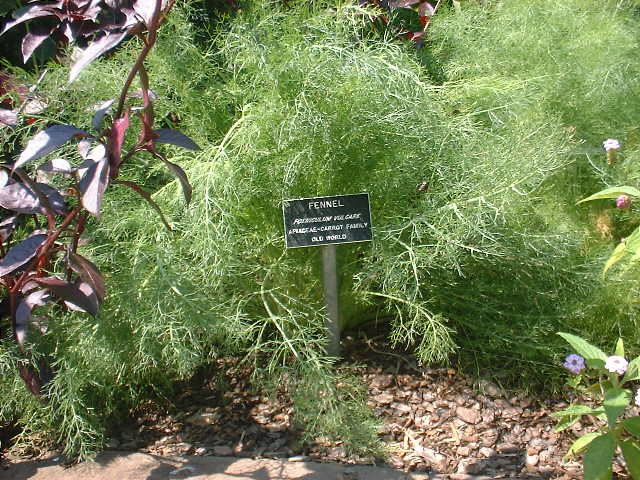|
Additional Fennel Information
Medicinal Uses
Recipes
Magic & Superstition
Herb Index Page
Site Map
Home
Annuals
Architectural Elements
Backyard
Habitat
Biennials
Bonsai
Bulbs
Cactus/Xeriscaping
Companions
Composting
Container
Gardening
Crafts
Gardening Q/A
Garden Ornamentation
Gargoyles
Greenhouses
Ground Covers
Herbs
Houseplants
Insects/Diseases
Landscaping
Organics
Perennials
Ponds
Propagation
Recipes
Roses
Seeds
Shade Gardens
Shrubs/Hedges
Tools
Trees
Vegetables
Vines
Weeds
Wildflowers
Wildlife
Shop Gardening
|
 Fennel
belongs to the Umbelliferae family, members of which also include angelica, anise,
chervil, coriander,
dill, and parsley.
It is native to central and western Europe, South Africa, and China. The
leaves can be used in fish, veal, and pork, and mixed with flavored butters,
oils, vinegars, and salad dressings. The seeds are used as a spice, mainly
for breads. Fennel
has feathery foliage and hollow stems. It is drought-hardy and will grow
just about anywhere. It is a perennial that can also be grown as an
annual. Established roots will overwinter easily. It will bolt with too
much heat, so start seed early in spring. It grows to up to six feet, and
flowers in mid-summer. Flowering is followed by a seed head with many
ribbed seeds. Fennel
belongs to the Umbelliferae family, members of which also include angelica, anise,
chervil, coriander,
dill, and parsley.
It is native to central and western Europe, South Africa, and China. The
leaves can be used in fish, veal, and pork, and mixed with flavored butters,
oils, vinegars, and salad dressings. The seeds are used as a spice, mainly
for breads. Fennel
has feathery foliage and hollow stems. It is drought-hardy and will grow
just about anywhere. It is a perennial that can also be grown as an
annual. Established roots will overwinter easily. It will bolt with too
much heat, so start seed early in spring. It grows to up to six feet, and
flowers in mid-summer. Flowering is followed by a seed head with many
ribbed seeds.
Fennel is a host for Swallowtail Butterflies, which
spend their entire life cycle either on or near it, and as such, it is a
valuable part of any garden habitat. The flowers also attract beneficial
bees. Be careful where you plant Fennel, however, as
many other plants will not do well in close proximity to it. See Companion
Planting for more details.
|
 |